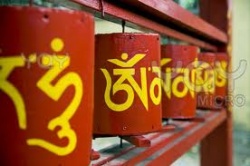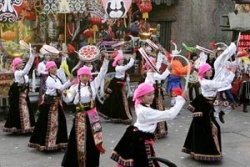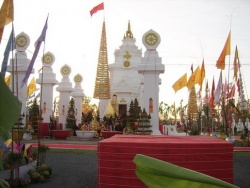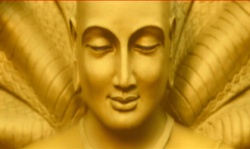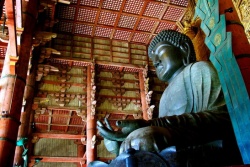Nichiren Buddhism
Nichiren Buddhism is a Japanese Buddhist movement in the Mahayana tradition. It is also popular in the West and has a fast growing membership in the UK.
Nichiren Buddhism differs from other schools of Buddhism in focusing on this world, and in its view that it is the only correct tradition. It also emphasises the importance of individuals taking responsibility for improving themselves.
Although it can be seen as a highly self-focused religion, followers of Nichiren Buddhism believe that individual empowerment and inner transformation contribute, in turn, to a better and more peaceful world.
The singer Tina Turner is one of its most high profile followers. In the 1993 movie What's Love Got to Do with It, an autobiographical film about Turner's rise to stardom and her relationship with her abusive husband, she chanted the Buddhist Nam Myoho Renge Kyo mantra.
Beliefs: instant enlightenment
This is one of the key elements of Nichiren Buddhism. It teaches that enlightenment is available to everybody. One writer has encapsulated this idea as a "shortcut to salvation".
The essence of enlightenment is opening a person's innate Buddha-nature in this world.
Triple refuge
Triple refuge means the Buddha, the dharma or law, and the sangha or community.
In Nichiren Buddhism, Nichiren himself is regarded as the Buddha, while the dharma is in the chant and the gohonzon.
The Nichiren Shoshu school of Buddhism teaches that the sangha is the priesthood alone, while Soka Gakkai does not restrict the sangha in this way.
Ten principles
Nichiren Buddhists believe in ten basic principles as fundamental to human make-up. These are:
Hell - a condition which appears when someone feels in despair or desperate.
Hunger - when someone constantly wants something, for example, to be like someone else rather than accept their own life.
Animality - is governed by instinct and may lead someone to prey on those more vulnerable. For example, a power hungry boss may abuse his position and treat his/her staff like slaves.
Anger - encompasses traits of selfishness, competitiveness, and arrogance.
Tranquillity - is a calm state of life.
Rapture - is the pleasures one feels when one's desires are fulfilled.
Learning - appears when someone seeks new skills.
Absorption is a condition based on knowledge and wisdom.
Bodhisattva - means 'disciple of the Buddha' and is a state where people have strong concern for others which ultimately helps them to overcome their challenges.
Buddhahood - is the ultimate state to be in as it includes compassion, wisdom, and humaneness.
Early History
Development
Nichiren Buddhism began in medieval Japan. It has its roots in the teachings of Nichiren Daishonin (1222-1282), a 13th century Japanese monk who tried to reform Buddhism and Japanese society. In many ways he was a Buddhist Martin Luther who lived centuries before the great Protestant reformer.
His teaching was based on the Mahayana sutra (scripture) known as the Lotus Sutra.
The book of 28 chapters of poems and stories is the main scripture of Nichiren Buddhism. The Lotus Sutra was probably compiled over 200 years and completed around 50-150 CE.
Nichiren came to regard the Lotus Sutra as a supremely authoritative scripture. He taught that it should always be read and applied to the contemporary context -- to the time and place in which the reader happened to be.
The Lotus Sutra has influenced Japanese Buddhism in general, and not just Nichiren Buddhism.
Seeking enlightenment
Nichiren came to believe that he was living in a degraded age, an age of mappo (very similar to the English term "end times") where Buddha's teachings were misinterpreted and as a consequence many bad things were happening.
Nichiren followed the Lotus Sutra in his teaching that all living beings could attain enlightenment on earth and could do this through chanting and 'human revolution'.
Nichiren emphasised the Lotus Sutra to the extent that he taught that it was the only way that could lead to true Buddhahood, and create a truly good world.
He taught that other Buddhist practices no longer provided a road to enlightenment, and that it was the neglect of the Lotus Sutra that was responsible for the evils of his time; including such things as earthquakes.
Nichiren was not just a scripture scholar, he was an activist. Having worked out what was wrong with contemporary Buddhism he did something about it. He engaged in shakubuku. This Japanese word means "to break and subdue".
Exile and execution
Nichiren not only embarked on missionary work for his own cause, but also on energetic disparagement of rival Buddhist views, to the extent of warning that those who followed them were going to hell. This made him extremely unpopular with other Buddhist teachers.
Nichiren also rebuked the rulers of Japan for allowing rival Buddhist schools of thought to promote "erroneous teaching". The job of the government, he said, was to promote the Lotus Sutra and look after the monks who taught it. Unless the government did this, Nichiren and his monks were duty bound to oppose the rulers of Japan. Loyalty to the Lotus Sutra was more important than loyalty to country or secular authority.
He was exiled twice by the government and some of his disciples were executed. He refused to compromise his principles and continued to challenge the established schools of Buddhism.
During his second exile on Sado Island he wrote letters of encouragement to his disciples which later formed some of his most important works.
In 1274, he was freed and the government cleared him of any wrongdoing. He died on October 13 1282, surrounded by his closest disciples.
Today there are many schools of Nichiren Buddhism. The largest are the Soka Gakkai, Nichiren Shoshu and Nichiren Shu.
The Soka Gakkai is the only Buddhist group in the West that has attracted a significant multi-racial membership. With just over 10,000 active members in the UK (January 2008 figure), the movement is unusual in the Buddhist tradition. It has many centres throughout Britain run by the Soka Gakkai movement.
Unlike other schools of Buddhism, its members actively proselytise. Similarities can still be drawn between Nichiren practice and other forms of Buddhism.
Nichiren Buddhists meet weekly or fortnightly in their own homes. Members of the practice are given a Gohonzon (scroll), so that they can practice at home rather than going to a temple.
People are divided into groups based on their location and will appoint an overall leader of the group, a men's and women's leader and a youth division leader. This is a very structured arrangement which can be reproduced universally.
Pilgrimages are made to the head temple of the Nichiren Shoshu school of Buddhism at Taisekiji, near Fujinomiya City in Shizuoka Prefecture, Japan, where the Dai-Gohonzon is kept, together with the ashes of Nichiren Daishonin.
Soka Gakkai
Value Creating Society
Nichiren Daishonin's Buddhism was passed from generation to generation in Japan for 700 years giving rise to over thirty different Nichiren denominations in Japan.
In 1930 a lay society known as the Soka Gakkai (Value Creating Society) started to spread its teachings.
Soka Gakkai was founded by the educators Tsunesaburo Makiguchi and Josei Toda, who had found parallels between Nichiren's teaching and their philosophy of education.
They followed in Nichiren's political footsteps, challenged the militaristic government during World War Two and were imprisoned for opposing government interference in religion. Makiguchi, who was the society's first president, died in jail on November 18 1944.
After the war, the Japanese constitution allowed freedom of religion for the first time. Toda reconstructed the Soka Gakkai as a movement for people in all aspects of society, not just in education.
By the time he died on April 2 1958 the organisation had reached more than 750,000 households and some of its members had been elected to the Japanese Parliament.
Daisaku Ikeda became the third President on May 3 1960, aged only 32. Under his leadership the organisation grew rapidly and expanded abroad.
In 1975 Soka Gakkai International was established and he became its first president. There are now more than 12 million members in 188 countries worldwide.
In the early 1990s there was a serious split between Soka Gakkai and the Nichiren Shoshu Head Temple. Soka Gakkai objected to various issues concerned with the roles played by the temple priests and was eventually rejected by the Temple organisation.
Soka Gakkai principles
Soka Gakkai is a distilled form of Nichiren Buddhism, and its teaching that spiritual (and perhaps material) happiness for an individual are achievable in this world through a simple spiritual practice has gained great popularity.
Although this teaching sounds egotistical, Soka Gakkai members are greatly concerned with others, and believe that world peace can be attained by people developing basic principles of altruism, supporting others, non-violence and self development.
Nichiren Shoshu
Conflict
Followers of Nichiren Shoshu believe that they belong to the true school of Nichiren Buddhism.
This belief is disputed by other schools of Nichiren Buddhism.
The dispute hinges on the interpretation of two documents Minobu sojo and Ikegmai sojo. These documents state that Nikko (1246-1333) is the successor of Nichiren Daishonin, the founder of Nichiren Buddhism.
Nichiren Shoshu Buddhists argue that Nichiren was the divine reincarnation of Buddha Sakaymuni (563-483 BCE).
Nichiren Shu, however, teaches that Nichiren was not a Buddha but a priest. This is the main doctrinal difference between these two schools of Buddhism.
Other beliefs and practices
Nichiren Shoshu Buddhists believe that personal enlightenment can be achieved in one lifetime.
The fundamental object of worship is the Gohonzon, believed to have been inscribed by Nichiren Daishonin himself on October 12, 1279.
Nichiren Shoshu practioners revere the Gohonzon as being at the heart of Nichiren's enlightenment. Each successive Nichiren Shoshu High Priest produces and consecrates a new Gohonzon. Every worshipper or Nichiren Shoshu household owns a smaller transcription of this scroll. New believers are issued with a copy at their initiation.
Every morning and evening, Nichiren Shoshu practioners renew their faith by performing Gongyo - the recitation of certain chapters of the Lotus Sutra and the chanting of Nam Myoho Renge Kyo.
Split with the Soka Gakkai
The Soka Gakkai is based on Nichiren Shoshu teachings. The two organisations split in 1991 and now work as separate bodies.
Nichiren Shu
Oldest sect
Nichiren Shu (or 'Nichiren Faith') is the oldest of the Nichiren Buddhism sects.
Smaller and less well known than the other schools, Nichiren Shu is still seen as being the most mainstream of the Nichiren sects.
This is because followers of Nichiren Shu have maintained links with non-Nichiren Buddhist traditions.
Believers are allowed to take part in other Buddhist spiritual practices, such as silent meditation or Sho Daigyo. They also study the foundational concepts of Buddhism such as the Four Noble Truths and Taking Refuge.
They do not accept Nichiren Shoshu teaching that Nikko was the sole successor of Nichiren Daishonin, the founder of Nichiren Buddhism.
Historical links
As the oldest Nichiren tradition, Nichiren Shu has access to Mount Minobu where Nichiren lived in seclusion and was buried.
The Nichiren Shu also owns some of the founder's most important personal possessions.
Unlike the Soka Gakkai, followers of the Nichiren Shu have not actively evangelised in the West. However its membership has grown in countries across the globe. The Nichiren Shu now ordains non-Japanese speaking priests and has expanded its temples throughout the western world.
Practices
Chanting
The main practice of Nichiren Buddhists is chanting, primarily the mantra Nam Myoho Renge Kyo which means 'I devote my life to the law itself'.
Chanters repeat this mantra to enter more deeply into the spiritual tradition of the Lotus Sutra.
Mantra: A mantra is a powerful phrase repeated over and over again with profound faith, concentration and feeling. Nam Myoho Renge Kyo is both the heart and title of the Lotus Sutra, which teaches the enlightenment of all living beings.
Believers also recite sections of the Lotus Sutra as part of their daily practice.
The chant is performed in front of a scroll called the Gohonzon.
Chanting is usually performed for about 30 minutes night and morning and is believed to bring about changes in a person's life and reverse bad karma.
What is Karma? Buddhists believe that our lives are conditioned by our past actions. Actions have consequences: good actions have positive consequences and selfish and unkind actions have negative consequences.
Nichiren Buddhists specifically believe that everyone can change their destiny and bring about the effects they desire. Followers are encouraged to write their personal goals down on a piece of paper and have it in front of them while chanting.
The aim of the practice is to establish high states of self-development. As Yukio Matsudo writes, it "works as a regular and constant inspiration to manifest the qualities of the Buddha in one's daily life."
Matsudo also writes:
[To chant) means to activate the innate Buddha-nature. The activated Buddha-nature... will then appear in one's life as enforced life power and wisdom to live like a 'lotus flower in a muddy pond'.
Yukio Matsudo, Protestant Character of Modern Buddhist Movements, Buddhist-Christian Studies, 2000
Chanting versus prayer: This chanting tradition is very different to the tradition of chanted prayer in many other religions. Those who practice it believe that the chant is "an influence at work in the metaphysical economy" and actually changes the force and action of karma.
Practitioners also believe that chanting works not by inviting some supernatural being or power to intervene and change karma, but by affecting karma directly (almost mechanically).
Origin of the chanting practice
The practice originated from Nichiren's teaching that the five characters that formed the title of the Sutra encompassed all the teachings of all the Buddhas.
The Sutra itself tells the reader that reading it is sufficient to achieve enlightenment (and also earthly benefits) - and the character it uses for reading implies reading aloud.
This simple recitation of the title in an act of homage is understood as opening the reciter to the infinite treasure house contained in the Lotus Sutra, and destines such a person to supreme enlightenment, not to mention assuring untold merit and worldly benefit.
Ruben L.F. Habito, Japanese Journal of Religious Studies 1999
Gohonzon
This Japanese word means 'supreme object of devotion or worship'. In Nichiren Buddhism it is a paper replica of a scroll originally inscribed by Nichiren. The original was carved on camphor wood and is preserved in the Taisekiji temple.
Followers keep their gohonzon in a small home altar, and face it during their daily chanting.
There have been disputes between the Soka Gakkai (Value Creating Society), and the Nichiren Shoshu priesthood over who has the power to create authentic gohonzons.
Other Practices
Study is an important part of the practice, as followers believe Buddhist study to be fundamental in illuminating one's path in life.
They also read Nichiren's writing in a book called the 'Gosho', which expounds his beliefs and insights through letters and stories.
Working for peace
A number of Nichiren Buddhist organisations are active in working for world peace. These include the monastic order Nipponzan Myōhōji which has built over sixty 'Peace Pagodas' in Japan, and Soka Gakkai which has a major peace education initiative.


